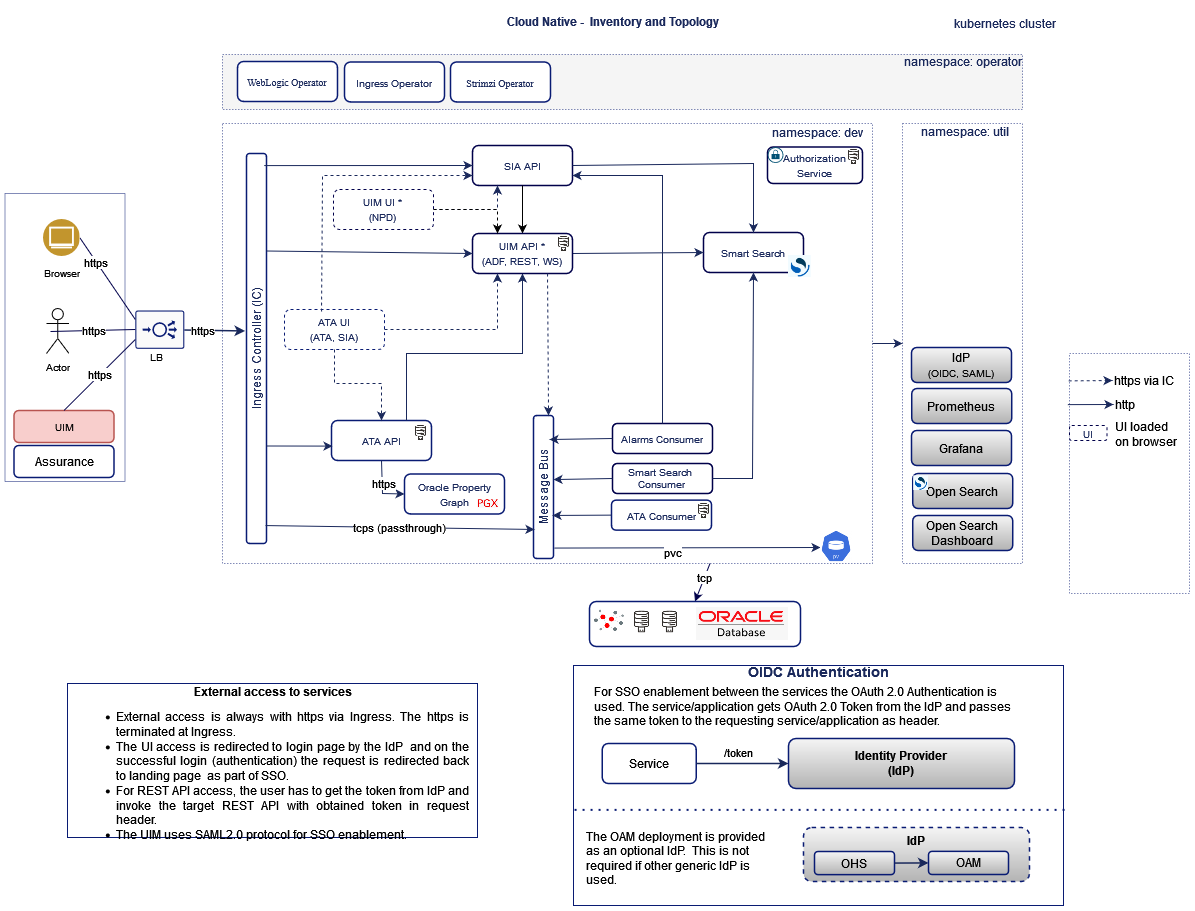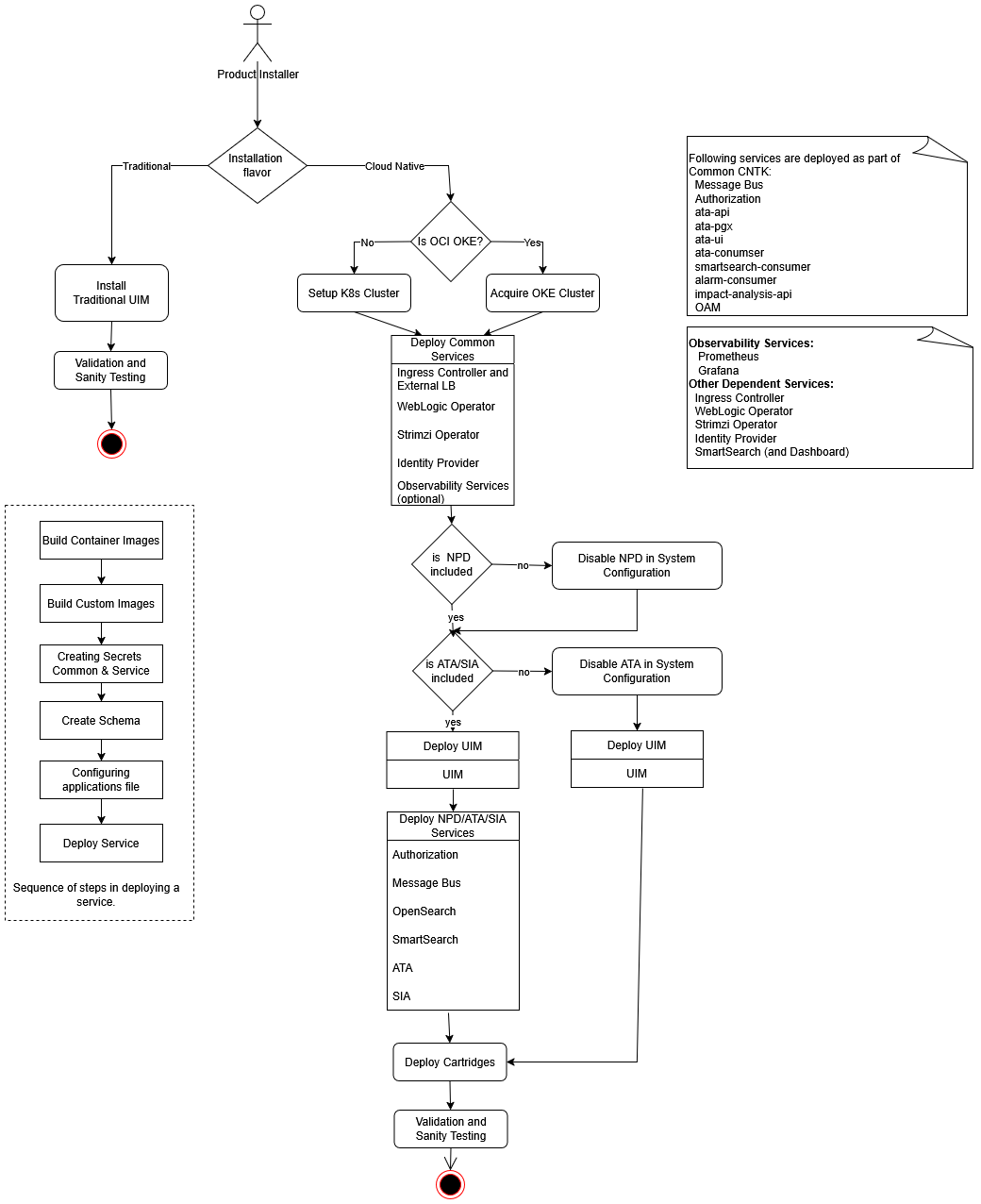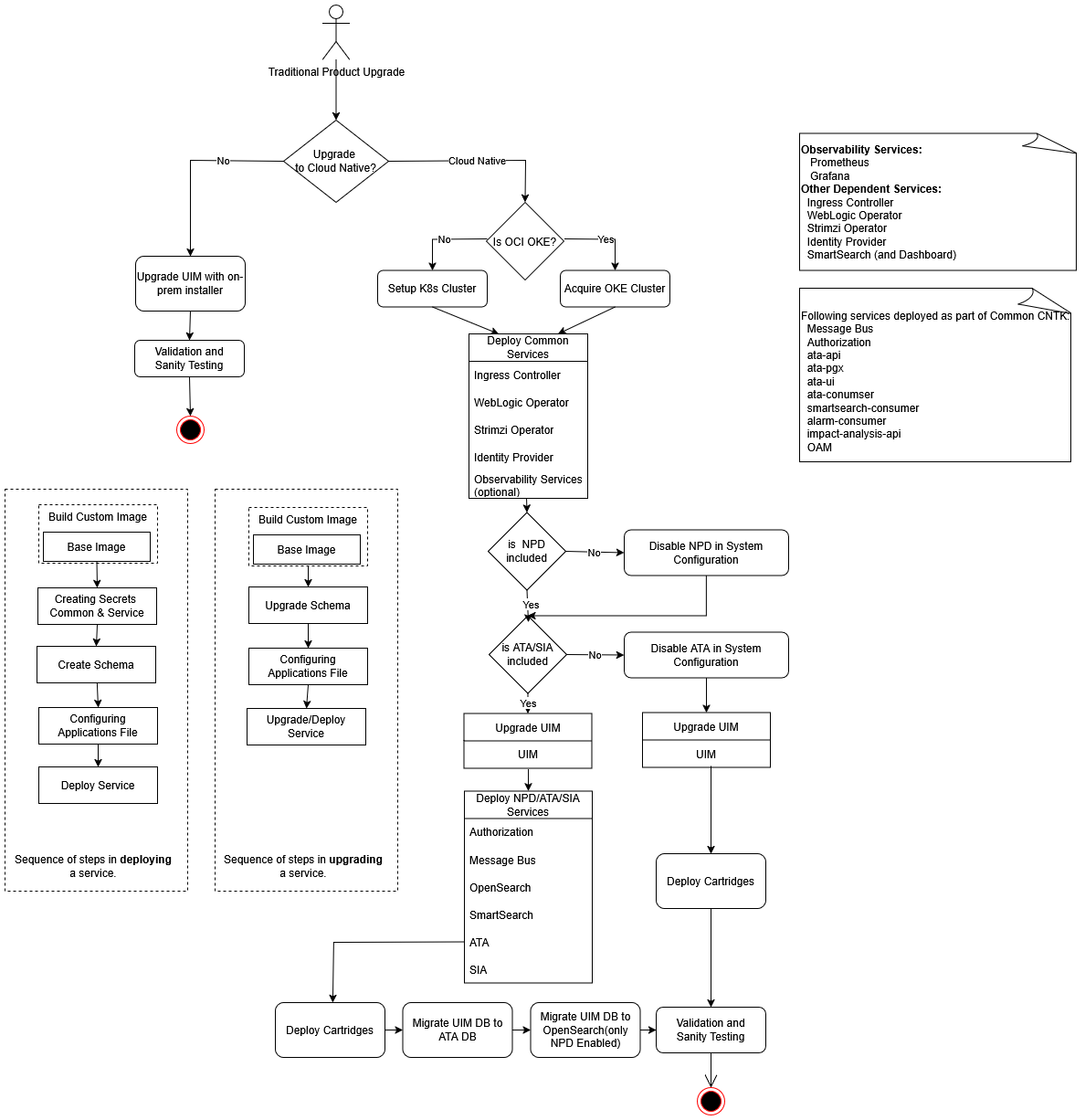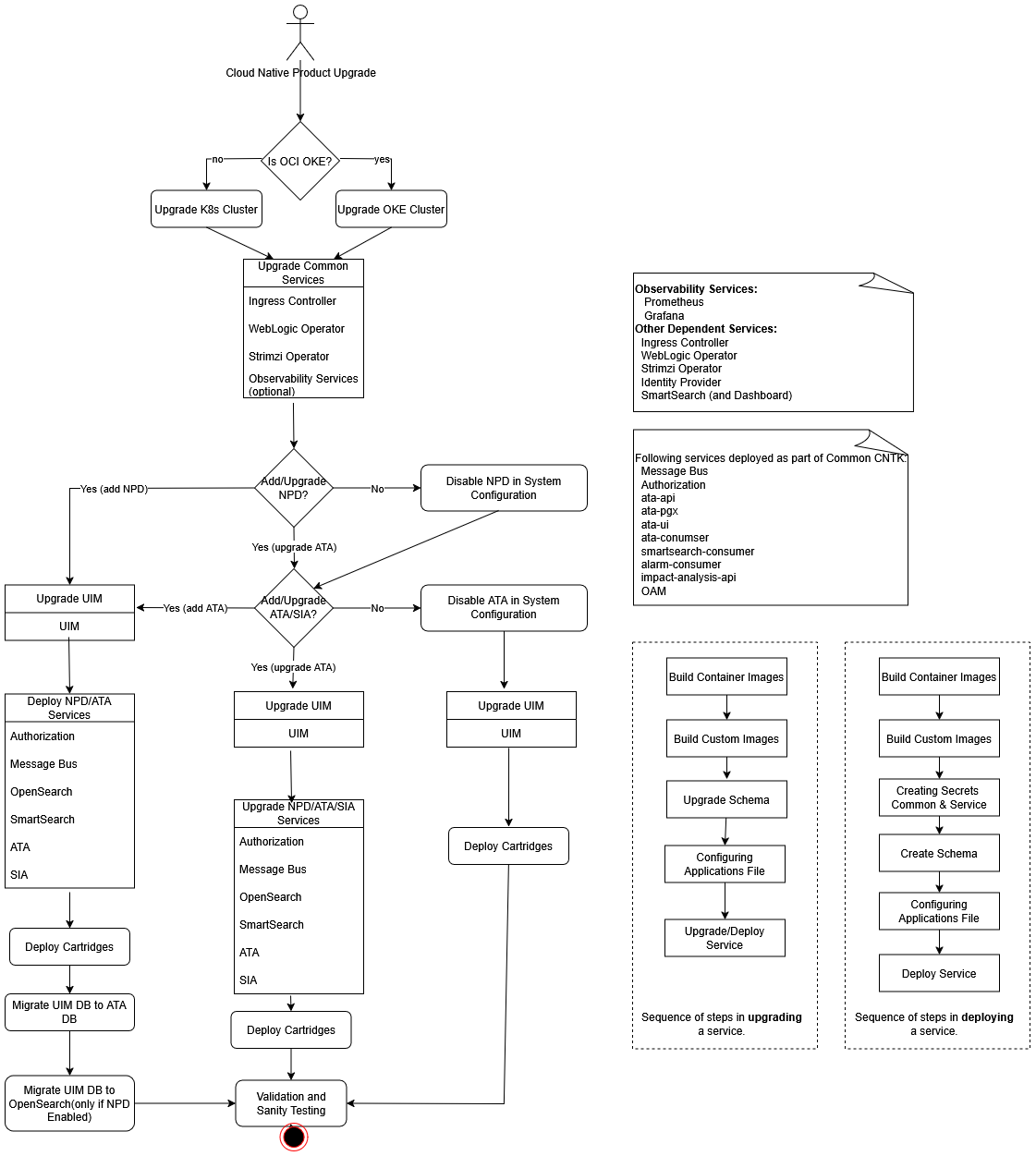1 About Unified Inventory and Topology
Unified Inventory and Topology includes the following services:
- Unified Inventory Management (UIM)
- Active Topology Automation (ATA)
- Authentication
- Authorization
- OpenSearch
- SmartSearch
- Unified Operations Message Bus
- Service Impact Analysis
ATA, Unified Operations Message Bus, Authentication, Authorization, Service Impact Analysis, and SmartSearch are cloud native containerized applications that are supported in a Kubernetes environment. UIM can be a traditional application or a cloud native instance.
- The embedded topology from UIM is now available as a micro-service (ATA) based on Helidon MP.
- The communication between UIM and the ATA service is asynchronous and this is achieved by using Message Bus service.
- Deploying Service Impact Analysis is dependent on ATA deployment. You must deploy ATA and create an ATA instance before deploying Service Impact Analysis.
Unified Inventory and Topology Architecture
The following figure shows a high-level architecture of Unified Inventory and Topology and how the services communicate.
Figure 1-1 High-level Architecture of Unified Inventory and Topology
See the corresponding architecture diagrams of the services for more information.
About UIM
UIM is a standards-based telecommunications inventory management application that enables you to model and manage customers, services, and resources. UIM supports complex business relationships and provides full life-cycle management of services and resources. UIM provides you with a real-time, unified view of customers, services, and resource inventory, enabling you to develop and introduce new services quickly and cost-effectively. UIM supports two deployment models: traditional (on-premise) deployment and cloud native deployment in a Kubernetes cluster.
About ATA
Active Topology Automation (ATA) enables you to view the service, network, and resource topologies in the form of topology graphs. ATA uses Oracle Property Graph DB to manage the topology hierarchy.
ATA enables you to view the service, network, and resource topologies in the form of topology graphs. ATA uses Oracle Property Graph DB to manage the topology hierarchy.
ATA has the following sub components.
- ATA API
- ATA PGX
- ATA Consumer
- ATA or Service Impact Analysis UI
- Alarm Consumer
- SmartSearch Consumer
- Service Impact Analysis
See Active Topology Automation and Service Impact Analysis User’s Guide for more information.
About Serivce Impact Analysis
Service Impact Analysis enables you to view the Assurance events associated with Inventory resources and view the impacts to customer, service, network, logical and physical resources, and connectivity.
Service Impact Analysis also enables you to assign ownership to specific individuals and track the impact lifecycle through the analysis process.
About Authentication
Authentication leverages SAML 2.0 (Security Assertion Markup Language) and Open ID Connect (OIDC) authentication protocol of Identity Provider (IdP) to implement the Single Sign-On (SSO) authentication solution with the services (UIM, ATA, Service Impact Analysis, Authorization, Message Bus, SmartSearch, OpenSearch). This enables you to seamlessly access multiple applications without being prompted to authenticate for each application separately. The main advantage of SSO is that you are authenticated only once, which is when you log in to the first application and you do not need to authenticate again when you subsequently access different applications within the same web browser session.
IdP also supports the single logout (SLO) feature. If you access multiple applications using SSO within the same web browser session, and then if you log out of any one of the applications, you are logged out of all of the applications.
Examples for authentication services are: IDCS, Keycloak, OAM, and so on.
For more information about IDCS, see https://www.oracle.com/technical-resources/articles/middleware/oracle-identity-cloud-service.html
For more information about OAM, see Administering Oracle Access Management
About Authorization
Authorization service defines a simplified and centralized approach for managing the authorization configurations for Unified Inventory and Topology services by defining the authorization policies. Authorization is the process of granting or denying access to specific resources based on the verified identity of a user whereas authentication is about verifying the identity of the user.
Authorization service is designed to provide permissions to access resources of an application for the authenticated user(s) with allowed role(s) or group(s).
Note:
Authorization service is not responsible to define users or assign role(s) or group(s) to the users.
Authorization service provides the capability to define various roles or groups in an application and define the permissions to resources under each role. For more information on Authorization, see "Deploying Authorization Service".
About OpenSearch
OpenSearch is a NoSQL database. It is an open-source search and analytics suite that makes it easy to ingest, search, visualize, and analyze data.
About SmartSearch
SmartSearch is a micronaut application, when integrated with OpenSearch, offers a powerful, flexible, and feature-rich search experience that can be tailored to specific business and user needs. Using OpenSearch as the underlying engine, SmartSearch can handle large volumes of data, perform real-time indexing, and support complex querying to enhance search relevancy. Features such as autocomplete, fuzzy matching, synonym recognition, and intelligent ranking make it easier for users to locate precise information, even if search terms are partially matched or misspelled.
About Unified Operations Message Bus
Message Bus is a distributed event store and stream-processing service. Message Bus service sends and receives events and messages asynchronously to a specific destination (called as Topic) between the services. The Message Bus service uses Apache Kafka, which is a distributed event store and stream-processing platform, as the messaging platform. For packaging or deploying, Strimzi is used. Strimzi simplifies the process of running Apache Kafka in a Kubernetes cluster. Strimzi also provides container images and operators for running Kafka on Kubernetes.
Planning UIM Installation
The following workflow helps you with information required for UIM installation.
Table 1-1 Planning UIM Installation Workflow
| Workflow Action | Reference | Description |
|---|---|---|
| Install Traditional UIM | Unified Inventory Management Installation Overview |
Provides information on installing traditional UIM using an on-premise installer. |
| Setup Kubernetes Cluster |
Planning and Validating Your Cloud Environment Installing Oracle Property Graph Plugin in Database https://strimzi.io/docs/operators/latest/deploying#considerations-for-data-storage-str https://kubernetes.io/docs/concepts/storage/storage-classes/ |
To deploy cloud native services, you must set up and validate a list of prerequisite software. Before starting the service deployments:
|
| Deploy Common Services | Download the required software and set the environment variables. | |
| Ingress Controller and External Load Balancer |
About Load Balancing and Ingress Controller |
You can use any Ingress Controller that conforms to the standard Kubernetes ingress API and that supports annotations required for UIM. Samples for Nginx are included in the toolkit. For a secure access of services, you must set up an Ingress Controller with TLS termination. TLS Termination setup for services is provided in deployment of each service. |
| WebLogic Operator | Installing the WebLogic Kubernetes Operator Container Image | The WebLogic Kubernetes Operator (operator) supports running your WebLogic Server and Fusion Middleware Infrastructure domains on Kubernetes. |
| Strimzi Operator | Strimzi Operator | Required only if ATA or NPD should be enabled. The Strimzi Operator supports deployment of Apache Kafka cluster on Kubernetes or OpenShift. |
| Identity Provider | Configuring Authentication for Services | You can use any Identity Provider (IdP) that supports SAML 2.0 (Security Assertion Markup Language) and OIDC (Open ID Connect) authentication protocols for implementing SSO (Single Sign-On) authentication solution among services. |
| Observability Services | Optionally, deploy services such as Grafana, Prometheus and OpenSearch for Metrics and Log Monitoring. | |
| Disable NPD in System Configuration | Not applicable. |
Modify $UIM_CNTK/charts/uim/config/system-config/custom-config.properties to disable NPD: |
| Disable ATA in System Configuration | Not applicable. |
Modify $UIM_CNTK/charts/uim/config/system-config/custom-config.properties to disable ATA: |
| Deploy UIM | ||
| Build Container Images | Creating UIM Cloud Native Images | |
| Build Custom Images | Customizing Images | This is optional. Required while extending the base image. |
| Create Secrets | Creating Secrets | |
| Create DB Schema | Installing the UIM and RCU Schemas | |
| Update Application Configurations | Setting System Properties | |
| Deploy Service | Creating a Basic UIM Instance | |
| Deploy NPD/ATA Services | ||
| Authorization | Deploying Authorization Service | |
| Message Bus | Deploying Unified Operations Message Bus | |
| OpenSearch | Deploying OpenSearch and OpenSearch Dashboard | Oracle OCI OpenSearch has to be used in OKE Cluster environment. |
| SmartSearch | Deploying SmartSearch | |
| ATA | Deploying the Active Topology Automation Service | If NPD is not required, update
$SPEC_PATH/<PROJECT>/<INSTANCE>/applications.yaml to
set SmartSearch Consumer replicaCount to
zero.smartSearchConsumer:
name: "smartsearch-consumer"
replicaCount: 0
|
| Service Impact Analysis | Deploying Service Impact Analysis | |
| Validation and Sanity Testing | Validation and Sanity Testing |
Validation and Sanity Testing
To perform validation and sanity testing:
- Log in to UIM using
https://<instance>.<project>.<hostSuffix>:<LB Port>/Inventory. - If NPD is enabled, select Create Network. The Verify Guided Flow
appears
- Enter Network Name.
- Select Create and Save New Location.
- Associate New Location to Network and click Continue.
- Add New Resource - Logical Device to Location.
- Select Continue and then click Finish. The Verify Network page appears.
-
If ATA is enabled, open ATA using
https://<instance>.<project>.topology.<hostSuffix>:<LB Port>/apps/ata-ui- Select Create New - Device.
- Enter new device name (from above) and click Search.
- Verify the device that appears.
Planning UIM Upgrade
This section provides information about planning your UIM upgrade for traditional and cloud native environments.
Planning Traditional UIM Upgrade
The following workflow helps you with information required for UIM upgrade.
Table 1-2 Planning Traditional UIM Upgrade Workflow
| Workflow Action | Reference | Description |
|---|---|---|
| Upgrade Traditional UIM | Upgrading Unified Inventory Management |
Provides information on installing traditional UIM using an on-premise installer. |
| Setup K8s Cluster |
Planning and Validating Your Cloud Environment Installing Oracle Property Graph Plugin in Database https://strimzi.io/docs/operators/latest/deploying#considerations-for-data-storage-str |
To deploy cloud native services, you must set up and validate a list of prerequisite software. Before starting the service deployments:
|
| Deploy Common Services | Download the required software and set the environment variables. | |
| Ingress Controller and External Load Balancer |
About Load Balancing and Ingress Controller |
You can use any Ingress Controller that conforms to the standard Kubernetes ingress API and that supports annotations required for UIM. Samples for Nginx are included in the toolkit. For a secure access of services, you must set up an Ingress Controller with TLS termination. TLS Termination setup for services is provided in deployment of each service. |
| WebLogic Operator | Installing the WebLogic Kubernetes Operator Container Image | The WebLogic Kubernetes Operator (operator) supports running your WebLogic Server and Fusion Middleware Infrastructure domains on Kubernetes. |
| Strimzi Operator | Strimzi Operator | Required only if ATA or NPD should be enabled. The Strimzi Operator supports deployment of Apache Kafka cluster on Kubernetes or OpenShift. |
| Identity Provider | Configuring Authentication for Services | Not applicable. |
| Observability Services | Optionally, deploy services such as Grafana, Prometheus and OpenSearch for Metrics and Log Monitoring. | |
| Disable NPD in System Configuration | Not applicable. |
Modify $UIM_CNTK/charts/uim/config/system-config/custom-config.properties to disable NPD: |
| Disable ATA in System Configuration | Not applicable. |
Modify $UIM_CNTK/charts/uim/config/system-config/custom-config.properties to disable ATA: |
| Upgrade UIM |
Moving to UIM Cloud Native from a Traditional Deployment Creating the UIM Cloud Native Images |
Not applicable. |
| Deploy UIM | Not applicable. | |
| Build Container Images | Creating UIM Cloud Native Images | Not applicable. |
| Build Custom Images | Customizing Images | This is optional. Required while extending the base image. |
| Create Secrets | Creating Secrets | Not applicable. |
| Create DB Schema | Installing the UIM and RCU Schemas | Not applicable. |
| Update Application Configurations | Setting System Properties | Not applicable. |
| Deploy Service | Creating a Basic UIM Instance | Not applicable. |
| Deploy NPD/ATA Services | Not applicable. | |
| Authorization | Deploying Authorization Service | Not applicable. |
| Message Bus | Deploying Unified Operations Message Bus | Not applicable. |
| OpenSearch | Deploying OpenSearch and OpenSearch Dashboard | Oracle OCI OpenSearch has to be used in OKE Cluster environment. |
| SmartSearch | Deploying SmartSearch | Not applicable. |
| ATA | Deploying the Active Topology Automation Service | If NPD is not required, update
$SPEC_PATH/<PROJECT>/<INSTANCE>/applications.yaml to set
SmartSearch Consumer replicaCount to
zero.smartSearchConsumer:
name: "smartsearch-consumer"
replicaCount: 0
|
| Service Impact Analysis | Deploying Service Impact Analysis | Not applicable. |
| UIM | Overview of the UIM Cloud Native Deployment | After UIM CN instance is created, redeploy the inventory.ear from admin console to update the new roles for NPD. |
| Migrate UIM DB to ATA DB | ATA DB Schema has to be created before migrating UIM Data to Graph DB. | |
| Migrate UIM DB to OpenSearch | Data Migration and Dynamic Attribute Mapping between UIM and SmartSearch | Data from UIM DB to OpenSearch NoSQL DB will be migrated with the help of SmartSearch and OpenSearch services. |
| Validation and Sanity Testing | Validation and Sanity Testing | Not applicable. |
Planning UIM Cloud Native Upgrade
The following workflow helps you with information required for UIM Cloud Native upgrade.
Table 1-3 Planning UIM Cloud Native Upgrade Workflow
| Workflow Action | Reference | Description |
|---|---|---|
| Upgrade Traditional UIM | Upgrading Unified Inventory Management |
Provides information on installing traditional UIM using an on-premise installer. |
| Setup K8s Cluster |
Planning and Validating Your Cloud Environment Installing Oracle Property Graph Plugin in Database https://strimzi.io/docs/operators/latest/deploying#considerations-for-data-storage-str |
To deploy cloud native services, you must set up and validate a list of prerequisite software. Before starting the service deployments:
|
| Deploy Common Services | Download the required software and set the environment variables. | |
| Ingress Controller and External Load Balancer |
About Load Balancing and Ingress Controller |
You can use any Ingress Controller that conforms to the standard Kubernetes ingress API and that supports annotations required for UIM. Samples for Nginx are included in the toolkit. For a secure access of services, you must set up an Ingress Controller with TLS termination. TLS Termination setup for services is provided in deployment of each service. |
| WebLogic Operator | Installing the WebLogic Kubernetes Operator Container Image | The WebLogic Kubernetes Operator (operator) supports running your WebLogic Server and Fusion Middleware Infrastructure domains on Kubernetes. |
| Strimzi Operator | Strimzi Operator | Required only if ATA or NPD should be enabled. The Strimzi Operator supports deployment of Apache Kafka cluster on Kubernetes or OpenShift. |
| Identity Provider | Configuring Authentication for Services | Not applicable. |
| Observability Services | Optionally, deploy services such as Grafana, Prometheus and OpenSearch for Metrics and Log Monitoring. | |
| Disable NPD in System Configuration | Not applicable. |
Modify $UIM_CNTK/charts/uim/config/system-config/custom-config.properties to disable NPD: |
| Disable ATA in System Configuration | Not applicable. |
Modify $UIM_CNTK/charts/uim/config/system-config/custom-config.properties to disable ATA: |
| Upgrade UIM |
Moving to UIM Cloud Native from a Traditional Deployment Creating the UIM Cloud Native Images |
Not applicable. |
| Deploy UIM | Not applicable. | |
| Build Container Images | Creating UIM Cloud Native Images | Not applicable. |
| Build Custom Images | Customizing Images | This is optional. Required while extending the base image. |
| Create Secrets | Creating Secrets | Not applicable. |
| Create DB Schema | Installing the UIM and RCU Schemas | Not applicable. |
| Update Application Configurations | Setting System Properties | Not applicable. |
| Deploy Service | Creating a Basic UIM Instance | Not applicable. |
| Deploy NPD/ATA Services | Not applicable. | |
| Authorization | Deploying Authorization Service | Not applicable. |
| Message Bus | Deploying Unified Operations Message Bus | Not applicable. |
| OpenSearch | Deploying OpenSearch and OpenSearch Dashboard | Oracle OCI OpenSearch has to be used in OKE Cluster environment. |
| SmartSearch | Deploying SmartSearch | Not applicable. |
| ATA | Deploying the Active Topology Automation Service | Not applicable. |
| Service Impact Analysis | Deploying Service Impact Analysis | Not applicable. |
| UIM | Overview of the UIM Cloud Native Deployment | After UIM CN instance is created, redeploy the inventory.ear from admin console to update the new roles for NPD. |
| Migrate UIM DB to ATA DB | ATA DB Schema has to be created before migrating UIM Data to Graph DB. | |
| Migrate UIM DB to OpenSearch | Data Migration and Dynamic Attribute Mapping between UIM and SmartSearch | Data from UIM DB to OpenSearch NoSQL DB will be migrated with the help of SmartSearch and OpenSearch services. |
| Validation and Sanity Testing | Validation and Sanity Testing | Not applicable. |
Installing Oracle Property Graph Plugin in Database
ATA uses Oracle Property Graph of Oracle Database that offers a powerful graph support to explore and discover complex relationships within ATA graphs.
Graph Server and Client is a software package that is required for Property Graph.
Creating Property Graph Roles
To create Property Graph roles, see Graph Developer's Guide for Property Graph https://docs.oracle.com/en/database/oracle/property-graph/24.4/spgdg/user-authentication-and-authorization.html#GUID-C006C651-DCA5-419D-859C-173840321408. Perform the steps 5 and 6 as a DBA on the database server to create the roles required by the graph server.



